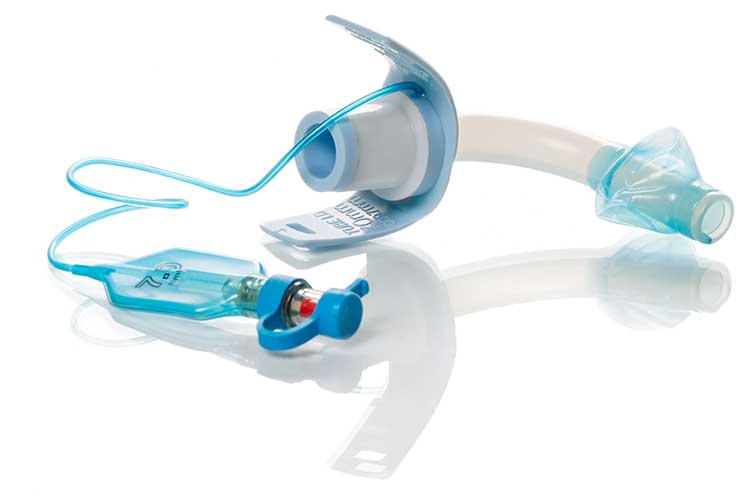Workers employed by National Disability Insurance Scheme (NDIS) providers, who deliver supports to NDIS participants with a tracheostomy tube in situ, must be able to provide appropriate care.
What is a Tracheostomy?
A tracheostomy is a surgical procedure that involves making an incision (stoma) into the trachea through the front of the neck. A tube is then inserted into the incision, creating an air passage that allows the patient to breathe directly through their trachea while avoiding their upper airway. This may be a temporary or permanent intervention (Healthdirect 2018; Mayo Clinic 2019).
It is vital to ensure you care for a tracheostomy tube carefully and thoroughly, as an adverse event such as respiratory distress may develop if the tracheostomy is not managed properly.

Tracheostomy Management in the NDIS Practice Standards
Tracheostomy Management is set out in the NDIS Practice Standards under the High Intensity Daily Personal Activities Module.
This Practice Standard aims to ensure that NDIS participants with a tracheostomy tube in situ receive appropriate suctioning and management that is relevant and proportionate to their individual needs (NDIS 2020).
Under these standards, NDIS providers must meet the following quality indicators:
- Participants are enabled to engage in the assessment and development of a tracheostomy management plan. This plan identifies possible risks, incidents and emergencies, and what actions need to be taken to manage these situations, including an escalation of care, if necessary. The participant’s health status is reviewed regularly (with their consent)
- Workers who provide tracheostomy care are informed by appropriate policies, procedures and training plans. These relate to the supports being provided to each participant
- Workers who provide tracheostomy care have received all necessary training that relates to each specific participant, either from a qualified health practitioner or another appropriately qualified individual.
(NDIS 2020)
Caring for a Tracheostomy Tube
Tracheostomy care under the NDIS should include:
- Adhering to personal hygiene and infection control procedures, and wearing appropriate PPE
- Monitoring the patient’s skin condition, maintaining the cleanliness of the incision (stoma) area and changing dressings
- Performing routine suctioning to ensure the patient’s airways remain patent
- Monitoring and reporting abnormal secretions
- Cleaning and maintaining suctioning equipment
- Supporting routine tube tie changes
- Keeping appropriate charts and records
- Identifying and responding to the signs of airway obstruction
- Implementing emergency procedures related to patient deterioration or infection
- Ensuring that an emergency tracheostomy kit is present at all times.
(NDIS 2018)
Staff Knowledge
NDIS workers who provide tracheostomy tube care are required to have knowledge of:
- The basic anatomy of the eliminatory system
- Skin and stoma care
- The types, components and functions of equipment, including speaking valves
- Risks and indicators of malfunction
- Indications that suctioning is required
- Requirements for monitoring and recording
- Common complications and how to manage them
- When to escalate care to a health practitioner
- Signs of infection (both in the respiratory system and the stoma site).
(NDIS 2018)

Potential Complications
Complications become more likely the longer the tracheostomy tube is kept in situ. Those who are critically ill or have comorbidities are more at risk (Fernandez-Bussy et al. 2015). Possible complications include:
- Tube obstruction
- Tube dislodgement
- Fistulae
- Infection
- Aspiration
- Tracheal damage or erosion
- Tracheal stenosis
- Formation of stomal or tracheal granulation tissue.
(Doyle & McCutcheon 2015; RCHM 2018)
Recognising Deterioration in Participants With Tracheostomy
Being able to identify the following signs of respiratory distress is crucial in promptly and appropriately addressing an emergency situation.
| Signs of Respiratory Distress | Possible Causes of Respiratory Distress |
|
|
(Adapted from NSW DoH 2015)
Conclusion
Knowing how to provide appropriate care to NDIS participants with a tracheostomy tube in situ is essential in preventing adverse consequences.
Additional Resources
- NDIS Practice Standards: Skills Descriptors | NDIS
- NDIS Practice Standards: NDIS Practice Standards and Quality Indicators | NDIS
- Care of Adult Patients with a Tracheostomy Tube | NSW DoH
References
- Doyle, G R & McCutcheon, J A 2015, Clinical Procedures for Safer Patient Care, BCcampus, viewed 15 June 2020, https://opentextbc.ca/clinicalskills/chapter/10-6-tracheostomies/
- Fernandez-Bussy et al. 2015, 'Tracheostomy Tube Placement', Journal of Bronchology & Interventional Pulmonology, viewed 15 June 2020, https://journals.lww.com/bronchology/Fulltext/2015/10000/Tracheostomy_Tube_Placement__Early_and_Late.19.aspx
- Healthdirect 2018, Tracheostomy, Healthdirect, viewed 15 June 2020, https://www.healthdirect.gov.au/tracheostomy
- Mayo Clinic 2019, Tracheostomy, Mayo Clinic, viewed 15 June 2020, https://www.mayoclinic.org/tests-procedures/tracheostomy/about/pac-20384673
- NDIS Quality and Safeguards Commission 2020, NDIS Practice Standards: NDIS Practice Standards and Quality Indicators, NDIS Quality and Safeguards Commission, viewed 15 June 2020, https://www.ndiscommission.gov.au/sites/default/files/documents/2019-12/ndis-practice-standards-and-quality-indicators.pdf
- NDIS Quality and Safeguards Commission 2018, NDIS Practice Standards: Skills Descriptors, NDIS Quality and Safeguards Commission, viewed 15 June 2020, https://www.ndiscommission.gov.au/sites/default/files/documents/2018-09/high-intensity-skills-descriptors.pdf
- New South Wales Department of Health 2015, Care of Adult Patients with a Tracheostomy Tube, New South Wales Department of Health, viewed 15 June 2020, https://www.aci.health.nsw.gov.au/__data/assets/pdf_file/0008/292580/Tracheostomy-care-nbm.pdf
- Royal Children’s Hospital Melbourne 2018, Tracheostomy Management, Royal Children’s Hospital Melbourne, viewed 15 June 2020, https://www.rch.org.au/rchcpg/hospital_clinical_guideline_index/Tracheostomy_Management_Guidelines/#Complications
 New
New 
